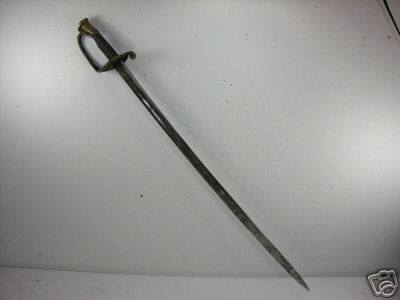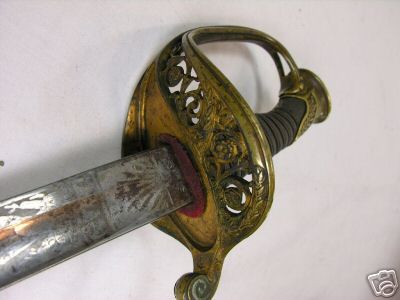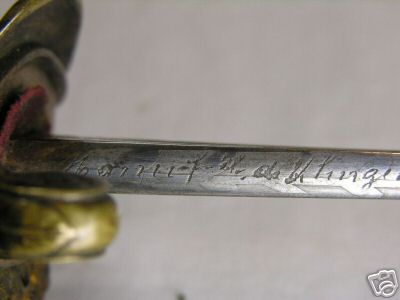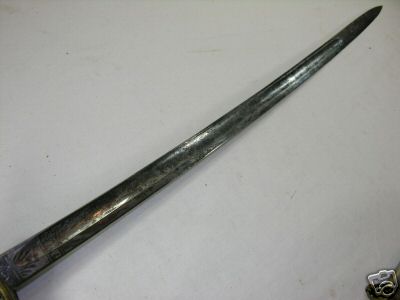| Author |
Message |
|
Olivier L-Beaulieu
Location: Québec, Canada Joined: 27 Jan 2007
Posts: 37
|
 Posted: Mon 19 Oct, 2009 10:49 am Post subject: Civil war sword... sharp? Posted: Mon 19 Oct, 2009 10:49 am Post subject: Civil war sword... sharp? |
 |
|
In my collection, I have a 1850 infantry officer sword made by the manufacture of Klingenthal. The blade is beautifully etched and stamped with two marks. The hilt is in fish skin and does not show any marks of combat. When I look to the edge of the blade, it does not seems to have been sharpened during it's working life time.
Is it possible that my sword have not been sharpened at all?
I forgot that some museum numbers are engraved on the blade.
 Attachment: 9.55 KB Attachment: 9.55 KB

 Attachment: 18.41 KB Attachment: 18.41 KB

 Attachment: 12.1 KB Attachment: 12.1 KB

 Attachment: 9.48 KB Attachment: 9.48 KB

 Attachment: 11.23 KB Attachment: 11.23 KB

|
|
  |
 |
|
Olivier L-Beaulieu
Location: Québec, Canada Joined: 27 Jan 2007
Posts: 37
|
 Posted: Tue 20 Oct, 2009 11:39 am Post subject: Posted: Tue 20 Oct, 2009 11:39 am Post subject: |
 |
|
|
anyone has information?
|
|
  |
 |
Chad Arnow
myArmoury Team


|
 Posted: Tue 20 Oct, 2009 12:02 pm Post subject: Posted: Tue 20 Oct, 2009 12:02 pm Post subject: |
 |
|
Sometimes answers take longer than 25 hours. Please have patience.

ChadA
http://chadarnow.com/
|
|
    |
 |
Sean Flynt

|
 Posted: Tue 20 Oct, 2009 1:49 pm Post subject: Posted: Tue 20 Oct, 2009 1:49 pm Post subject: |
 |
|
These were more badge of rank than functional weapon. They certainly can cause damage, but they're no match for a .50 ball. Yours might seem dull but it's sharp enough to kill or incapacitate. The spear point of these is suggestive of the most effective use, anyway--the thrust. I have an antique U.S. Model 1860 light cavalry saber I'm 99 percent certain was carried in combat, and it doesn't have an edge comparable to medieval swords. With these weapons the weight and point (and horse, in this case) do the work.
-Sean
Author of the Little Hammer novel
https://www.amazon.com/Little-Hammer-Sean-Flynt/dp/B08XN7HZ82/ref=sr_1_1?dchild=1&keywords=little+hammer+book&qid=1627482034&sr=8-1
|
|
   |
 |
|
Ken Speed
|
 Posted: Tue 20 Oct, 2009 2:30 pm Post subject: Posted: Tue 20 Oct, 2009 2:30 pm Post subject: |
 |
|
|
I've been kind of holding back on this in hopes that someone with more definite knowledge could give you an answer. What I've been told is that the sword, by this time, had become not only a badge of rank as Sean said but also an implement to signal troops on the parade ground and battle field rather than a weapon. So if the sword has become nothing more than a signaling device then there is very little need for it to be sharp.
|
|
  |
 |
|
Norman McCormick
|
 Posted: Tue 20 Oct, 2009 2:57 pm Post subject: Posted: Tue 20 Oct, 2009 2:57 pm Post subject: |
 |
|
Hi,
In the British Army of the 19th Century swords were only sharpened when going on campaign and as a result there are many, in fact the majority, are unsharpened as a lot of H.M. Forces, officers particularly, did not see combat. I would suggest that this was probably the practice throughout Western Europe at the time and therefore it would suggest that your sword's owner was never in a combat zone. Hope this helps.
Regards,
Norman.
|
|
  |
 |
|
Jonathan Hopkins
|
 Posted: Tue 20 Oct, 2009 3:24 pm Post subject: Posted: Tue 20 Oct, 2009 3:24 pm Post subject: |
 |
|
Is the sword marked "U.S." anywhere?
Thank you,
Jonathan
|
|
  |
 |
|
Michael Eging
|
 Posted: Tue 20 Oct, 2009 4:14 pm Post subject: Posted: Tue 20 Oct, 2009 4:14 pm Post subject: |
 |
|
I have a couple of French pieces from about the same period and they are also not sharp, but they have wicked tips. As Sean indicated, many of these at this period were either decorative, relied on other forces, or were used to thrust. Mine do appear to be well worn, so they may have seen some action, but they appear to have never been sharpened.
M. Eging
Hamilton, VA
www.silverhornechoes.com
Member of the HEMA Alliance
http://hemaalliance.com/
|
|
  |
 |
Glen A Cleeton

|
 Posted: Tue 20 Oct, 2009 6:48 pm Post subject: Posted: Tue 20 Oct, 2009 6:48 pm Post subject: |
 |
|
Here is an oldie but a goodie (if the server links cooperate).
Civil War Sabers Intentionally Left Unsharpened?
While it is often noted that swords of the American Civil War (by any title) were never sharpened, it is not difficult to find quite as many references to sharpened swords of that conflict. I do find that many of the earlier swords I own and thought to be used in America have been purposefully been filed/ground dull while some are quite sharp and apparently so from the get go and continue to be. My feelings on American use past the mid 19th century certainly does see less use of swords as tools and the other side of the pond quite vigorously maintaining sharp edges and fielding forests of blades. I do also have a couple of pieces from the Americana 1860s that were obviously never sharpened and one of those likely never even issued.
As to how sharp? Well, one (1800ish spadroon) came to me paper slicing sharp (won't push cut) and others are still quite sharp by definition but not quite paper trick sharp. I don't recall if it is the thread I linked but follow Jean Binck's old thoughts and his replies to sharpening on the continent. Troopers being issued a file and paper to polish, he had posted a verbatim reading regarding that. I really do see a general drop off of sword education during the conflict mentioned. There was somewhat of a continuance after the Mexican war years and what some might regard as the militia period after the 1812 conflict but many brought into the national fight in the 1860s simply didn't have a clue as to how to proceed. Many "cavalry" on both the north and south were better suited as mounted infantry chores and there simply were not the types of battles more seen and practiced by Europeans and the English.
It is quite true that artillery of all types (rifles, muskets and pistols as well) account for the bulk of casualties along with sickness.
Jonathan had a great Boer War era picture somewhere here in my files. A small crowd of kids (young men) at
the grinding station.
As to the sword in question, likely not U.S. identified, or truly to be attributed to the 1860s fight in America unless there is a lot of provenance behind the particular sword.
Anyway, I find sharp, never sharpened and dulled examples from the 19th century. Swords continued as sharps into the 20th century.
Cheers
GC
|
|
  |
 |
|
Olivier L-Beaulieu
Location: Québec, Canada Joined: 27 Jan 2007
Posts: 37
|
 Posted: Wed 21 Oct, 2009 8:01 pm Post subject: Posted: Wed 21 Oct, 2009 8:01 pm Post subject: |
 |
|
The sword is not marked "US". The seller told me that my sword was probably used by a Confederate officer. I also read (where?) that the Klingenthal shop was the only one allowed to sell swords in the US during Civil War.
My inspection of the blade show one sword (or other thing like that) nick and two unidentified nick (small "bumps" on the blade).
Your answers help me a lot to understand what happen to my sword in his past life.. Thank you. If someone has other information, please tell it.
|
|
  |
 |
Glen A Cleeton

|
 Posted: Wed 21 Oct, 2009 8:47 pm Post subject: Posted: Wed 21 Oct, 2009 8:47 pm Post subject: |
 |
|
HI Oliver,
Stories are cheap advertising for such swords. I am not sure where you read that Klingenthal was the only source but a brief jaunt through some browsing on dealer sites will show bushels of U.S. marked/etched ACW era officer swords, as well as many thousand cavalry swords coming from Germany.
The French swords use in the ACW is certainly valid but there is no indication this example was absolutley used so. Can you transcribe the date(s) on the spine of the sword? The truth is there have been many thousands of European swords assimilated into the American market and without better data, guessing that a sword was of ACW use is kind of a false premise. The two scabbarded swords I picture above are definitely of the era and the straight one clearly indicating those war years and some might easily attribute it to ACW use but that is likely a flase premise. As is my sabre pictured and absolutely right to be an unmarked German example and a prime story builder for the Confederacy possibilities but the model was used worldwide and just happened to be sold to me in America. It could easily be listed with a story in a sale but I hope I would make it clear if I was the seller. Fanciful but it is a prime candidate to have been there in any context during that war. I bought it simply as a good example of the genre. The big straight guy is clearly marked by the appropriate French controllers but its spine lettering is long gone and possibly removed to make a story for an ACW sword. To me, another case of simply another nice example (as you should consider your's)
As swords were often private purchase, just about any story could hold some water but the stories are unfortunately usually just stories. The date(s) would help your's, along with the small round marks if you can relate them better. if you look at that thread I linked and then visit Jean's page linked in his profile, there is some manufacturing background there.
Cheers
GC
|
|
  |
 |
|
Jonathan Hopkins
|
 Posted: Thu 22 Oct, 2009 5:36 am Post subject: Posted: Thu 22 Oct, 2009 5:36 am Post subject: |
 |
|
I agree with Glen. Without specific markings to the US, then one can only speculate. In this case I would say you have a nice French M1845 infantry officer's sword. I, too, am curious about the date given on the spine of the blade and I look forward to your response.
Jonathan
|
|
  |
 |
|
Jean-Carle Hudon
|
 Posted: Thu 22 Oct, 2009 11:58 am Post subject: Klingenthal Posted: Thu 22 Oct, 2009 11:58 am Post subject: Klingenthal |
 |
|
Salut Olivier,
even though Klingenthal closed in 1962, there is still a museum and an association devoted to their products.,and they provide a link to someone who may be able to provide info, for example did they produce for the CSA market, or any other north american market in the time period being researched, etc
http://www.klingenthal.fr/expertise.htm
Bon coeur et bon bras
|
|
  |
 |
|
Olivier L-Beaulieu
Location: Québec, Canada Joined: 27 Jan 2007
Posts: 37
|
 Posted: Thu 22 Oct, 2009 12:14 pm Post subject: Posted: Thu 22 Oct, 2009 12:14 pm Post subject: |
 |
|
I never saw a date on the spine of the blade.
Jonathan, I thought that my sword was a 1850 officer's sword. Could it be a 1845? Possible after all. What are the biggest differences between the 1850 and the 1845?
From my understanding, it could be a sword from any war in the seconde part of the 19th century. It is possible that my sword was never in the hands of a confederate officer because we don't know it's origins. I would want to know from which museum this sword comes from...
|
|
  |
 |
Glen A Cleeton

|
 Posted: Thu 22 Oct, 2009 1:09 pm Post subject: Posted: Thu 22 Oct, 2009 1:09 pm Post subject: |
 |
|
Hi Oliver,
The date on the spine of the blade (if apparent) should point straight to its manufacture date. Alternately, any round marks with letters in them can also help date it more specifically. These might be found on the brass hilt as well as under (or covered by) the blade washer/bumper. Those are mentioned in research as poincons. The letters are attributed to various inspectors and controllers. Toss the 1850 date right out the window unless the date is noted n the blade's spine.
There were a great number of American swords that were based specifically on French models. That may be why it was sold to you as an 1850 type sword and possibly used for a Confederate officer. See what I am getting at? The French model (mle 1845) was produced by Klingenthal up to and beyond the 1880s.
| Quote: | | I would want to know from which museum this sword comes from.. |
Was there any indication from the seller that it was from a museum? They type is unbelievably available and inexpensive, although it does look like a very nice example and not as common as undecorated blades.
Note here that no contract from either England or France for the Confederacy should/would have been marked by the manufacturer. Note also that although the 1860s war is somehow most glorified by sellers of all walks, please do not read into possibilities and speculation as fact. I it possible to say a French marked sword was used by a southern officer? Sure but pure speculation without more information (some of which you might be able to research from the markings) it is nothing but idle thought. There was one instance on another board when I wrote a quite fictional account of a British sloop getting past the blockades of Charleston to deliver munitions, including swords. An Ebay or dealer seller could have helped such tripe sell just about anyone that it might be real. Alternately, New Orleans would be a good source to build on.  True, odd lots of swords have thought to have been procured but (again) it becomes a matter of true provenance. True, odd lots of swords have thought to have been procured but (again) it becomes a matter of true provenance.
If there is an interest in American swords during the 19th century, one could do worse than picking up a book entitled The American Sword 1775-1945 by Harold Peterson. The title is widely distributed and available in most libraries as well as dirt cheap as a used book. While a little dated (and some of us a bit jaded) it really is regarded as the most basic and comprehensive for its time.
Let's hope to concentrate on dating its manufacture first.
Cheers
GC
|
|
  |
 |
|
|

